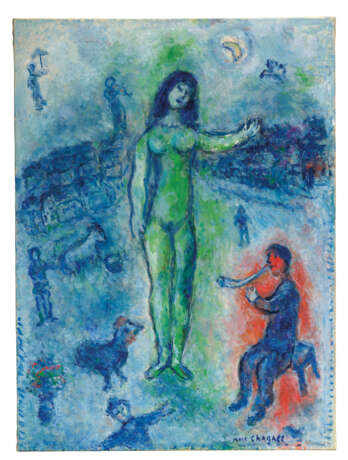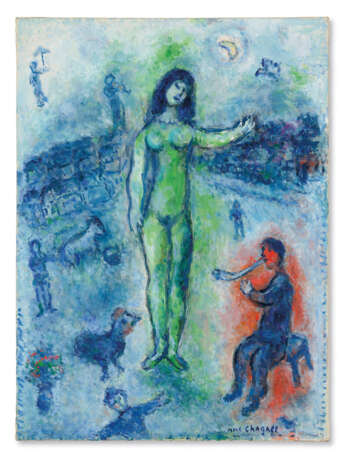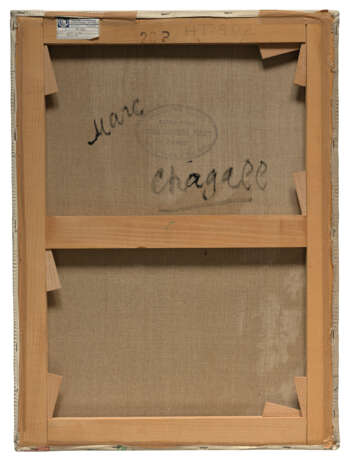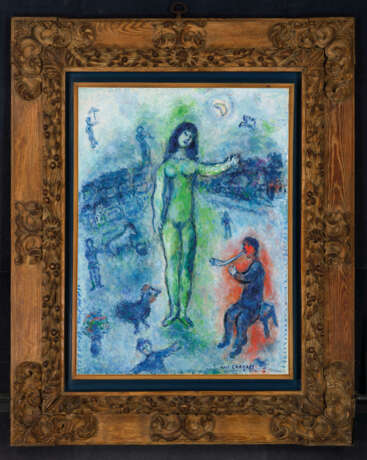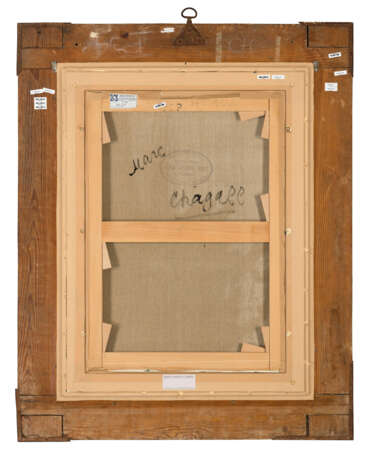ID 832347
Los 129 | Marc Chagall (1887-1985)
Schätzwert
€ 600 000 – 900 000
Célébration du nu vert
signé ‘MArc ChAgAll’ (en bas à droite); signé ‘Marc Chagall’ (au revers)
tempera et huile sur toile
72.7 x 54 cm.
Peint vers 1981-82
signed ‘MArc ChAgAll’ (lower right); signed ‘Marc Chagall’ (on the reverse)
tempera and oil on canvas
28 5/8 x 21 1/4 in.
Painted circa 1981-82
Provenance
Atelier de l'artiste.
Galerie Daniel Malingue, Paris.
Collection particulière.
Galéria Barbié, Barcelone.
Acquis auprès de celle-ci par le propriétaire actuel en 2009.
Special Notice
Artist's Resale Right ("droit de Suite").
If the Artist's Resale Right Regulations 2006 apply to this lot, the buyer also agrees to pay us an amount equal to the resale royalty provided for in those Regulations, and we undertake to the buyer to pay such amount to the artist's collection agent.
ƒ: In addition to the regular Buyer’s premium, a commission of 5.5%
inclusive of VAT of the hammer price will be charged to the buyer.
It will be refunded to the Buyer upon proof of export of the lot
outside the European Union within the legal time limit.
(Please refer to section VAT refunds)
Post Lot Text
« Je pense que seuls l’amour et un dévouement désintéressé envers les autres pourront conduire à l'harmonie suprême dans l'art et dans la vie dont l’humanité rêve depuis si longtemps. Et cela doit, bien entendu, se manifester dans chaque parole, dans chaque coup de pinceau, et dans chaque couleur. »
Chagall, in J. Baal-Teshuva, éd., Chagall: A Retrospective, Westport, 1995, p. 208.
“I thought that only love and uncalculating devotion towards others will lead to the greatest harmony in life and in art of which humanity has been dreaming so long. And this must, of course, be included in each utterance, in each brushstroke, and in each colour.”
Chagall, quoted in J. Baal-Teshuva, ed., Chagall: A Retrospective, Westport, 1995, p. 208.
Peint vers 1981, Célébration du nu vert illustre parfaitement l'onirisme envoûtant qui caractérise la vision artistique si particulière de Chagall. La composition a pour sujet et point de mire une femme vaporeuse, éthérée, dont le corps, bien que dénudé, irradie d'un vert éclatant qui conbtraste avec les douces teintes bleues de l'arrière-plan. Autour de cette silhouette gravitent des formes animales, des objets allégoriques et des personnages qui semblent tour à tour lui rendre hommage, l'orner ou lui jouer la sérénade. Dans Célébration du nu vert, Chagall revisite ainsi la figure de la muse de l'artiste et le mêle à l'un de ses thèmes de prédilection, le sentiment amoureux, bien souvent associé à l'image de sa première épouse, Bella, dans son œuvre. Malgré la mort soudaine de celle-ci en 1944, Bella demeurera l'égérie principale de Chagall tout au long de sa carrière. L'infatigable passion entre l'artiste et sa muse, un sujet que Chagall aborde notamment dans Le Peintre et le grand nu de 1984, trouve une résonance musicale dans Célébration du nu vert ; ici, la beauté captivante du corps féminin est non seulement exaltée par le pinceau de Chagall, mais aussi par la figure du musicien qui s'affiche à droite de la nymphe et qui semble jouer un morceau en son honneur. À l'instar de la femme qui exhale une lueur verte, le soliste, lui, rutile de rouge, rayonnant à la manière des commandes de vitraux monumentaux que l'artiste réalise durant cette période.
Si Chagall s'impose en coloriste dès ses débuts, ce n'est qu'à sa maturité que sa gamme de couleurs s'épanouit pleinement et trouve enfin tout son éclat. Pour l'artiste, travailler le vitrail revient à peindre avec la lumière. C'est cette expérience avec le verre qui va lui permettre d'obtenir son emblématique palette de nuances vives et intensément lumineuses, dont regorge notamment la présente œuvre. Ici, le rouge du personnage masculin, une figure d'artiste, vient contrebalancer le vert de la muse, de façon à créer entre les deux protagonistes une harmonie de tons percutante, aux accents célestes. Constellée de symboles qui évoquent la joie et l'amour (la chèvre, l'oiseau, la lune et surtout le bouquet de fleurs, élément récurrent de l'œuvre du peintre qui apparaît ici sur le pan gauche de la toile), Célébration du nu vert est un tableau profondément romantique, très représentatif du travail tardif de Chagall. Infusant l'ensemble d'une atmosphère toute singulière, ces motifs sont baignés d'un azur d'une expressivité extraordinaire, tonalité qui s'est imposée comme l'un des aspects les plus magistraux des dix dernières années de production du peintre. En 1976, à l'âge de quatre-vingt-neuf ans, Chagall a matière à rétrospection ; malgré l'existence heureuse qu'il mène depuis de longues années à Saint-Paul-de-Vence aux côtés de sa seconde épouse Vava, son esprit est encore largement occupé par sa Russie natale et sa jeunesse auprès de Bella, un souvenir ravivé en 1973 par un voyage émouvant en URSS après plus de cinquante ans d'absence. À ce stade, Chagall jouit déjà d'une grande reconnaissance et peut s'offrir le luxe de méditer paisiblement sur sa carrière, dont le succès est couronné au cours des années 1970 par l'ouverture du musée national message biblique Marc-Chagall en 1973, suivi de la grand'croix de la Légion d'honneur qu'il recevra en 1977. Rassemblant certains des éléments les plus éloquents de son répertoire plastique, ce tableau fascinant, à la fois romantique et contemplatif, témoigne du calme et de la créativité que Chagall a su trouver au crépuscule de sa vie.
Painted circa 1981, Célébration du nu vert is a striking example of the mesmerizing dream world that characterizes Chagall’s distinctive artistic vision. The subject and focal point of the composition is an ethereal woman, whose body, although nude, glows green against a soft blue background. Her corpus is framed by human figures, animal forms and potent motifs which each serenade, celebrate, or adorn her.
In Célébration du nu vert Chagall, revisits the figure of the artist’s muse. Romance is a recurring theme within Chagall’s oeuvre and is often a reference to Chagall’s first wife, Bella. Although Bella unexpectedly passed away in 1944, she continued serve as Chagall’s primary muse throughout his lifetime. The lasting passion between the artist and muse, which would be the principal theme of Chagall’s Le Peintre et le grand nu of 1984, here finds a musical iteration; the artistically inspiring beauty of the nude woman is transcribed not only by Chagall’s brush, but is captured in the figure of the musician to her right, who is in the midst of celebrating and serenading her. Just as the woman glows in green, the inspired musician radiates red, shining like the stained glass commissions that the artist was executing at this time.
Chagall had, from the outset of his career, established himself as a colourist, but it was not until this latter part of his life that colour achieved its full radiance and plenitude in his work. The artist regarded his work in stained glass as similar to painting in light. It is this approach which enabled Chagall to create his distinctive, bold palette with such intense luminosity, that which is seen so clearly in the present work. Here, the red of the man, the artist figure, complements the green of the female muse, and the two figures enter into a powerful cosmic colour harmony.
Populated with evocative symbols of romance and joy, the goat, the bird, the moon, and above all the vase of flowers, present throughout his oeuvre and seen here to the left of the composition, Célébration du nu vert is a deeply romantic painting characteristic of Chagall’s later works. Lending the work its distinctive atmosphere, these motifs are presented within a beautifully soulful blue palette, a hue which became one of the most celebrated features of Chagall’s final decade. By 1976, aged eighty-nine, Chagall had much to reflect on; Russia and his early life with Bella remained at the forefront of his mind—even more so following his emotional visit there in 1973 after an absence of over fifty years—yet at the same time he had now been happily settled in Saint-Paul-de-Vence for many years with his second wife Vava. By this point widely acclaimed, this was a period when he could reflect in comfort on his artistic success; a position consolidated in the 1970s by the opening of the Musée national message Biblique Marc Chagall in 1973 and then by the presentation of the grand'croix de la Légion d'honneur in 1977. Bringing together some of the artist’s most iconic and enduring themes, this wonderfully romantic, meditative, and inspiring work is testament to the creativity and the calm that Chagall had found in his final decades.
| Adresse der Versteigerung |
CHRISTIE'S 9 Avenue Matignon 75008 Paris Frankreich | ||||||||||||||
|---|---|---|---|---|---|---|---|---|---|---|---|---|---|---|---|
| Vorschau |
| ||||||||||||||
| Telefon | +33 (0)1 40 76 85 85 | ||||||||||||||
| Fax | +33 (0)1 40 76 85 86 | ||||||||||||||
| Nutzungsbedingungen | Nutzungsbedingungen | ||||||||||||||
| Versand |
Postdienst Kurierdienst Selbstabholung | ||||||||||||||
| Zahlungsarten |
Banküberweisung | ||||||||||||||
| Geschäftszeiten | Geschäftszeiten
|
